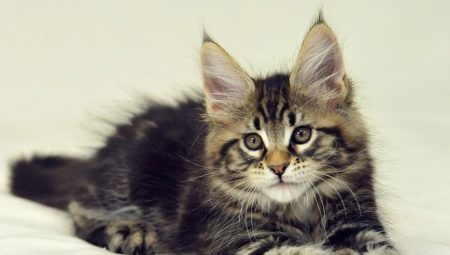Maine Coons are the graceful affectionate giants in the cat world. You need to buy a kitten in four months, it is at this age that all breed defects and health problems, if any, become visible. Provided that the kitten is properly maintained and nourished, the kitten can grow up to be a champion and an enviable producer.
Breed standards
Standards were introduced to control the breeding work of breeders, since the purity of the breed can only be preserved if the parents meet the criteria for pure breed in all key respects.
The Maine Coon breed has the following strict standards:
- the size of cats and cats should differ significantly (males are larger);
- the body is large with a wide chest;
- paws muscular and round, tufts of wool between the fingers;
- wide tail reaches the shoulder;
- the hair on the tail is flowing;
- large square skull;
- the profile of the muzzle is curved;
- eyes are large, slightly slanted, set wide;
- eye color is harmonious with coat color;
- ears wide at the base, tapering to the tips with tassels and copious margin, set close;
- the coat is dense, waterproof, has a different length (longer on the stomach and hind legs);
- the undercoat without the main hair on the abdomen and “pants”;
- mane is optional, but adds points for the overall appearance of the animal.
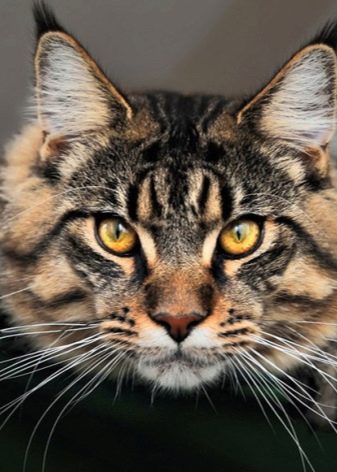
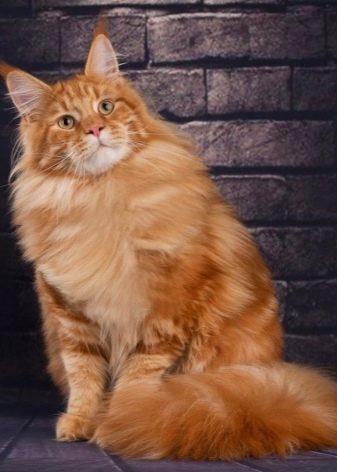
Maine Coon specimens grow up to the age of three years, but after the first year of life they already look like adults, weight gain and growth are noticeably slowed, sometimes jumps in development can be observed. Participation in exhibitions is permitted from the age of three months, but the award of titles starts from ten months.
There are three rating systems for this breed.
- WCF (Russia) - the animal is examined at an open exhibition in the presence of the owner. For one day, one rating is given.Evaluation criteria: a body that meets the standard is evaluated at 35 points, head - 40 points, color and quality of coat - 25 points, eye color - 5 points, general appearance - 5 points. Disqualified for hybrid colors: chocolate, lilac, Siamese, and so on, as well as for long hair on the stomach.
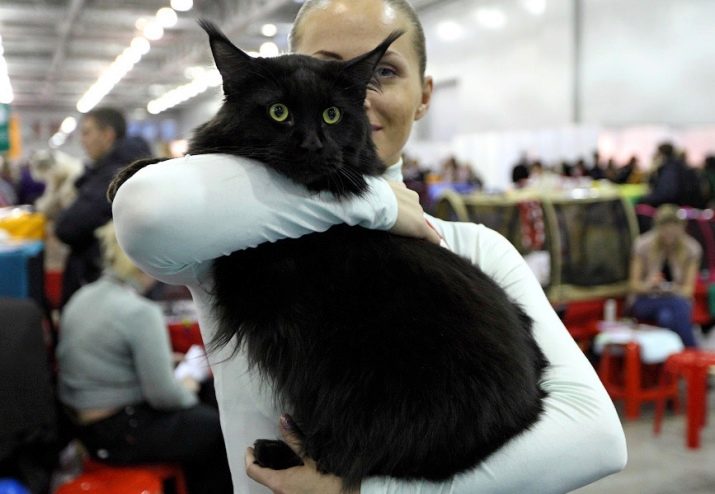
- TICA (America) - the animal is seen in a stretch. There is a system of fines for a short tail, slanting wide eyes, a narrow chin, ears in the shape of a flame, a narrow body and a rare coat. Disqualification is provided for the aggressive behavior of the animal, creases on the tail, blindness, narrow body. Ratings: head - 40 points, body - 35 points, wool on the totality of parameters - 25 points.
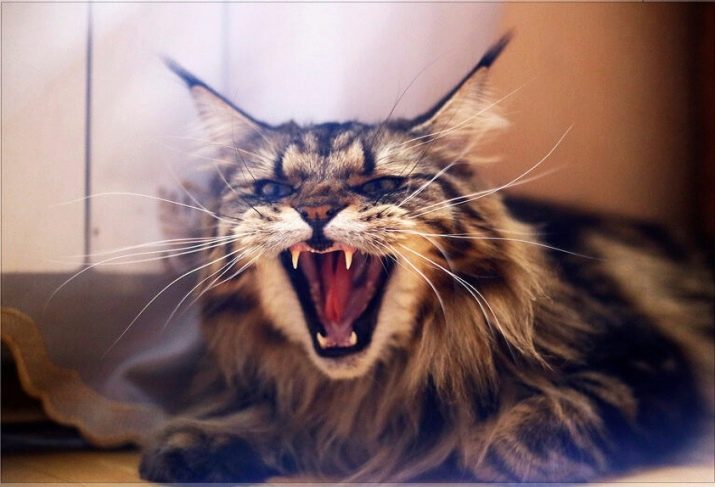
- FIFe (France) - pure color of eyes, a powerful neck at cats are welcomed, seasonal molting is taken into account. Disqualification for WCF and TICA systems. Ratings: head - 40 points, body - 35 points, wool - 20 points, general condition - 5 points.
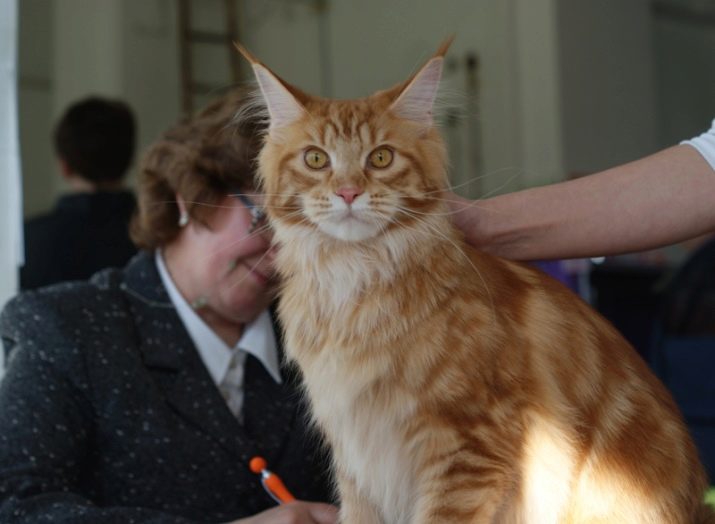
All systems of standards for evaluating Maine Coons are the same in terms of origin and temperament: parents should be titled, the character is friendly and balanced.
If the kitten meets the standards, it will be a success at all kinds of shows.
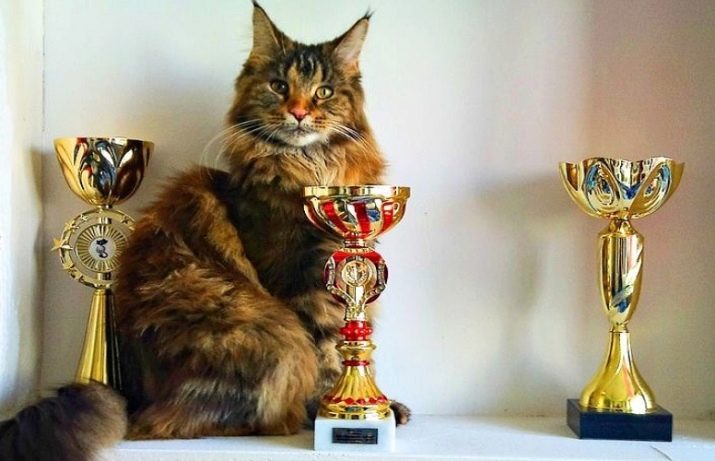
What affects growth?
The large dimensions of the representatives of this breed give a large load on the spine, and too rapid growth affects the formation of joints badly.
The following factors affect the growth of Maine Coon kittens:
- gender of the newborn - boys are born larger and grow faster than girls;
- weight and height of mom cat - the larger it is, the larger the offspring is born;
- health status - weak kittens grow slower and gain weight worse;
- the number of individuals in the litter - the larger the number, the smaller the newborns;
- heredity - paternal genes also affect the growth and development of kittens, if the male is relatively small, then the offspring will be small;
- feeding a nursing cat - a lack of nutrients and vitamins will adversely affect the growth of kittens;
- stress - building noise, loud music, the presence of other cats or dogs in the room - all this badly affects both the cat and kittens; there are frequent cases when the female stopped feeding offspring after a stressful situation and the kittens were significantly behind in gaining weight on artificial nutrition.
It is recommended the first year to keep a diary of the weight and height of Maine Coon kittens (it is advisable to use electronic scales) in order to timely detect developmental abnormalities, if any.
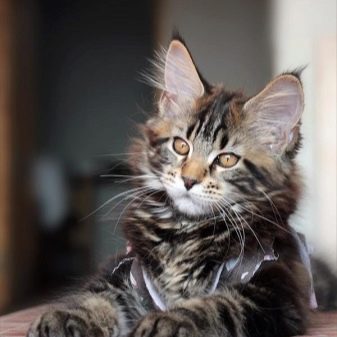
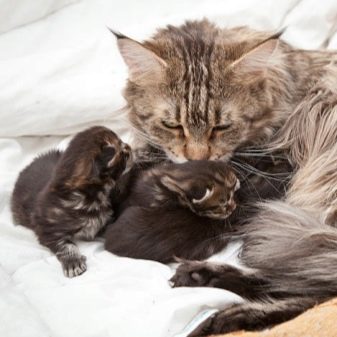
Kittens development by months
Kittens are born weighing about 100-130 grams. The more kittens in the litter, the less weight each. Girls are 20 grams behind the boys in weight, but must steadily gain weight. Strong large cats give birth to stronger offspring. Strong and healthy kittens grow faster than weakened ones. At the age of four months, boys begin to grow faster than girls and add more weight.
Kittens must be kept clean, protected from stress and temperature changes, then they will harmoniously and fairly quickly develop and grow. The Maine Coon female, which has been nursed, needs to be varied and balanced fed at least 4 times a day. It is necessary to introduce complementary foods in the kittens ’diet, the first days a new product must be given 1/5 teaspoon, bringing the volume by the end of the week to two tablespoons.
The development of Maine Coon kittens by months is as follows.
- The first month the normal weight gain of a kitten is considered to be 10 grams daily (except for the first 3-5 days, when the kitten recovers from stress received during childbirth). By the end of the first month of life, the weight of a healthy kitten increases approximately fourfold (girls about 600 g, boys about 800 g), weak monthly kittens are close in all respects to their strong brothers. Kittens during this period feed exclusively on breast milk.
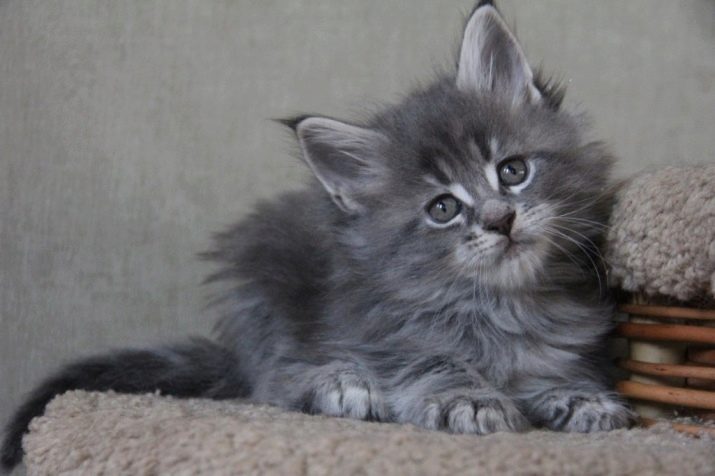
- Second month ends with an increase in weight by 8 times compared with newborns: two-month-old cats grow up to 1300 grams, cats - 1600 grams. To mother’s milk, complementary foods are added once a day to scalloped scalded meat at the tip of a teaspoon for each kitten.
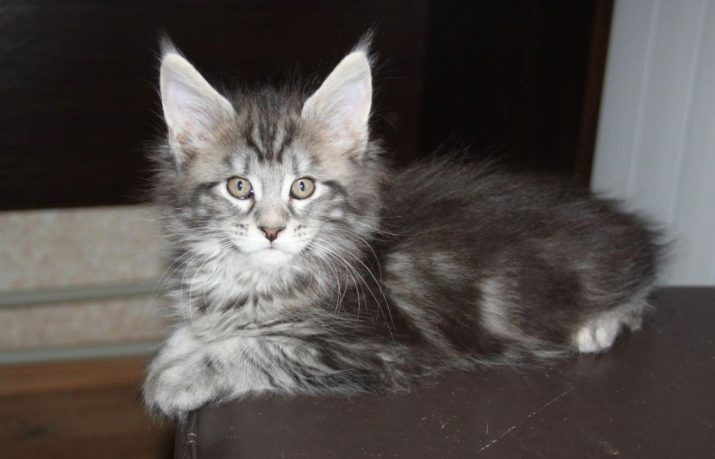
- For the third month in addition to mother’s milk and scraped meat, baby turkey puree can be added to the diet of babies, the weight of cats by this moment reaches 2400 grams, and cats - 3600 grams.
Three-month-old kittens can be weaned gradually from mother's milk.
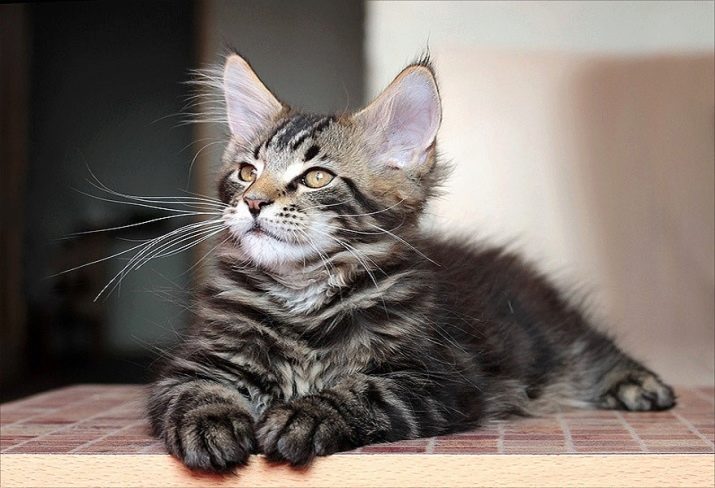
- In the fourth month special milk for kittens and liquid cereals are added. Kittens master the tray well. At this age, kittens are sold and they change their place of residence, which can inhibit growth and weight. A cat at this time should weigh about 3500 grams, a four-month-old cat - about 3800 grams.
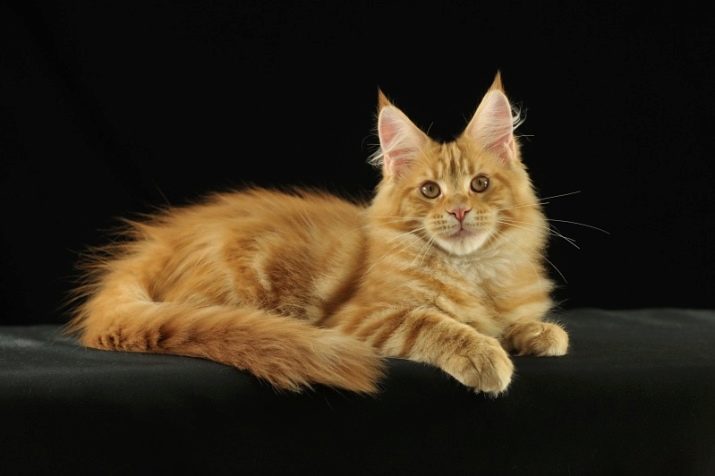
- Fifth month - This is the maximum weight gain. The diet remains the same. Growth slows down somewhat. The teenage phase is coming. Girls at this age have a weight of 4200 grams, boys - 5500 grams.
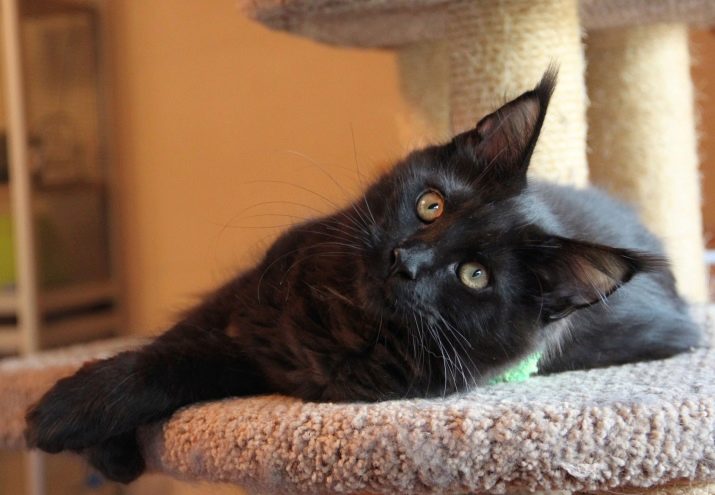
- Sixth month - the time of the sterilization (if necessary), the kitten must first be examined by a veterinarian. The diet of Maine Coon remains unchanged. Girls gain up to 4300 grams, boys - about 5100 grams.
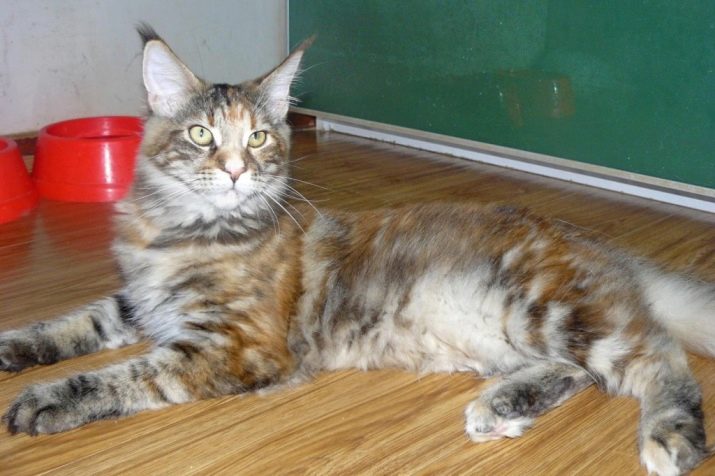
- Seventh month low-fat cottage cheese, sour cream 15% is added to the diet. At the age of seven months, the teeth in kittens are fully formed. Cats weigh about 4600 grams, cats - 6500 grams.

- Eighth month - time to introduce boiled egg yolk into the diet. Girls gain weight up to 5000 g, boys add about 0.5 kg in weight and become 6.9 kg.
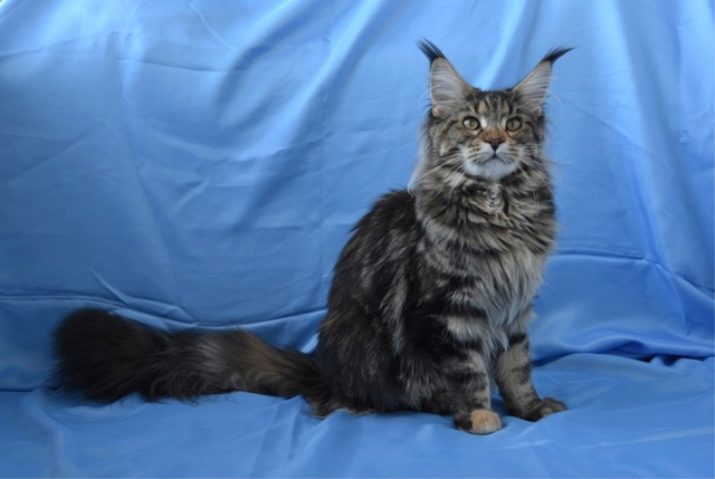
- For the ninth month diet can be expanded: add vegetables. The weight of girls becomes about 5200 g, boys - about 7 kg.
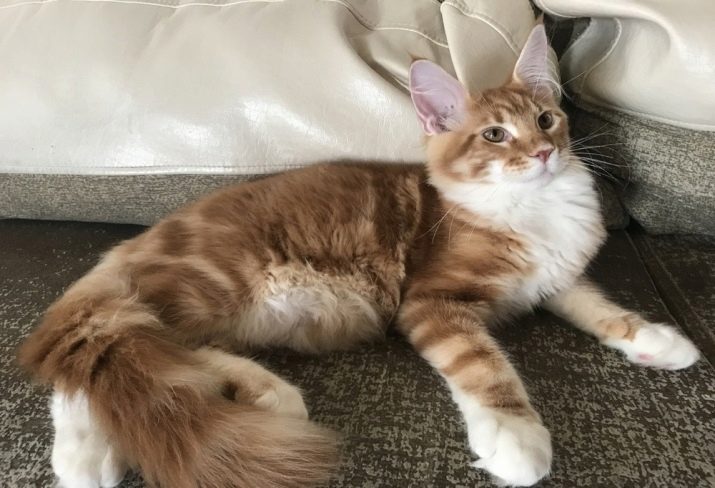
- For the tenth month You can add boiled sea fish of low-fat varieties to the Maine Coon menu. The weight of girls is 5500 g, boys - 7700 g.
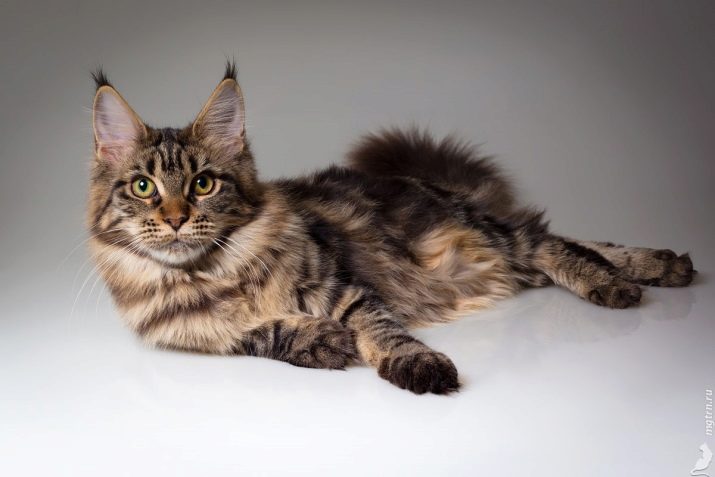
- Eleventh month - the diet remains the same. Females gain weight about 6100 g, males - about 7200 g.
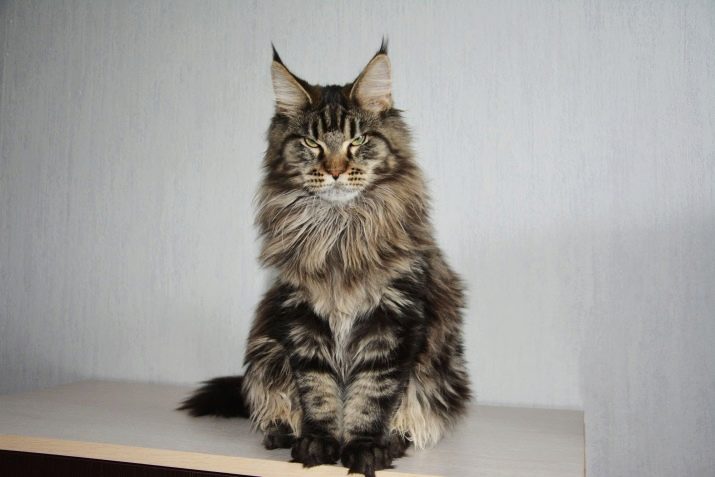
- By year diet is maintained. Girls weigh 6500 g, boys weigh 9 kg.
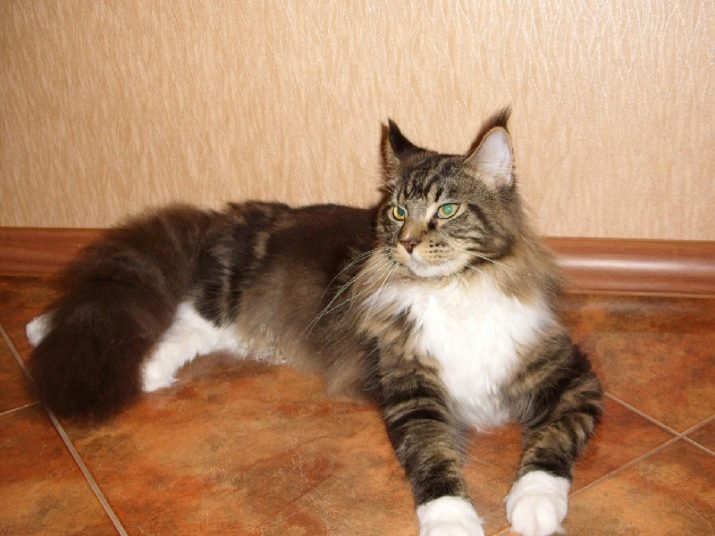
The average weight of an adult Maine Coon male is about 10 kg. Do not overfeed the animal in pursuit of weight gain - this will cause irreparable harm to the health of the pet and significantly reduce its life expectancy.
What to do if the cat is not gaining weight?
The diet of Maine Coon kittens should be balanced and varied, promote normal growth, weight gain within the normal range, and also contain vitamins and minerals. Overweight negatively affects the cardiovascular system, hormonal levels and joints of the animal.
Weight gain also depends on the period of development of the kitten, namely:
- neonotal - This is the first 4 days from birth, at this time kittens lose weight;
- suction - the first month of life, there is a steady increase in weight of about 30 grams daily;
- transition - this is the second month after birth, there is some weight loss with the introduction of complementary foods;
- post-suction - the time of a complete transition to a separate diet without breast milk, the first 5-7 days of this period may be inhibited in growth and weight gain, but after the first week the indicators stabilize.
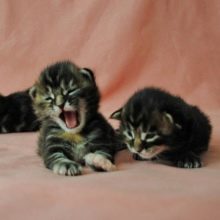
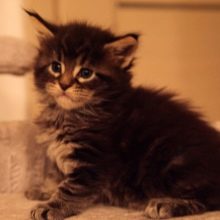

If the kitten is gaining weight poorly, it should never be fed sausage, cow's milk and pork - these products will not help to increase weight, but will undermine the pet’s health.
Maine coons, like all thoroughbred cats, need constant monitoring by a professional veterinarian, which allows timely identification of health problems and cure the animal (a doctor should be visited at least 2 times a year). Kittens of this breed are very active and cheerful, often energy is consumed faster than accumulated. A noticeable weight gain begins as you grow older, after some decrease in activity.
The largest among adult individuals are castrated males, but their weight should not exceed 11-12 kg. If the animal weighs more - this indicates obvious health problems. Maine Coons look giants due to their considerable growth and fluffy wool with a thick undercoat.
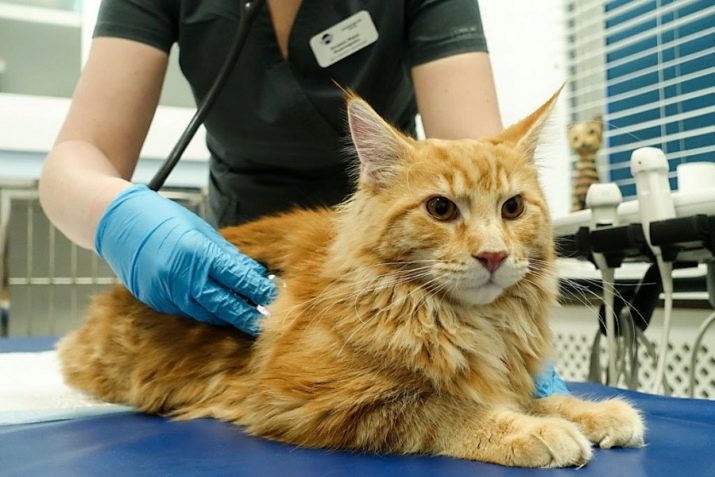
More about Maine Coon kittens in the next video.
